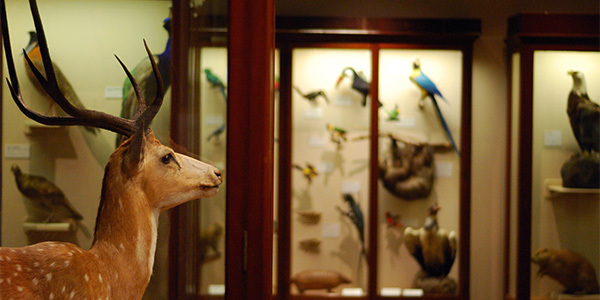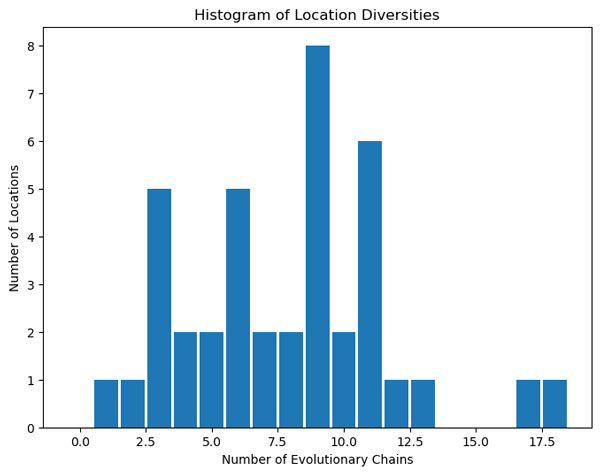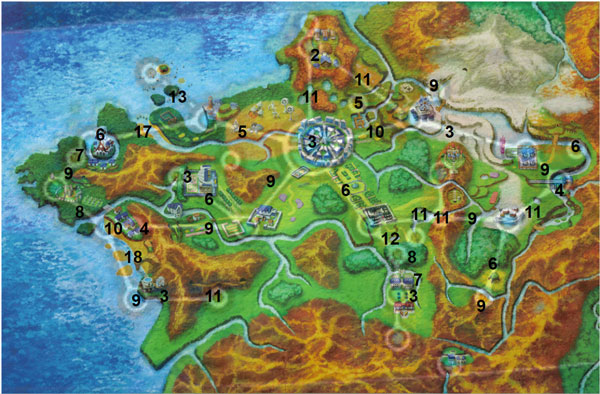Scientizing imaginary ecologies
Postdoctoral Researcher Brennen Fagan considers the implications of the creature collecting media.

No doubt like many other households, mine has had its encounters with Pokémon. It’s not unusual to discuss something Pokémon-related with my child once or twice a week. They watch the show every so often, have some stuffed animals, and even a Pikachu (electric mouse) pillow. This last week though, I got curious. While at dinner, I asked, “What does Pikachu eat?”
“... berries.”
“And what about Meowth (greedy cat)?”
My child paused to think, and I offered, “Do you think Meowth eats Pikachu?”

Cat and Mouse, by allen watkin, CC-BY-SA 2.0
The no was quick, but not as confident as the first response. My child’s answer jumped to berries, and then settled on “Team Rocket Food” (the comically inept bad guys). I let that matter drop and changed tact. “Are there any animals that aren’t Pokémon?” My child’s brain seemed to trip over this idea. For instance, some Pokémon are clearly based on plants, but not all plants are Pokémon in the franchise, so I think my child wasn’t quite certain whether to extrapolate or not. After all, animals that aren’t Pokémon aren’t exactly the focus of Pokémon (although they rarely can be spotted, with uncertain canonicity).
Of course, the predator-prey relationship offered above isn’t a focus of the franchise either. Much of the game play is about Pokémon fighting each other, which has probably normalised cartoon violence for my child although somehow without doing the same for animal-animal violence, even with the occasional nature documentary.
With a franchise as big as Pokémon, and many smaller competitors springing up in the “Creature Collector” genre, it’s unsurprising that an academic eye has been studying the effects. For instance, Rangel et al. (2022) considered whether Pokémon can be used educationally by specifically extracting examples of ecological interactions from the official Pokémon list (but see also pokemondb and bulbapedia). Then classifying the interactions ecologically and the Pokémon under their morphologically similar taxa, and presenting the examples to students to illustrate the specific ecological interaction. They found that this was generally successful, even amongst students who were not fans of the franchise already.
But there is a subtler issue at play that Rangel et al. also touch on; how realistic is Pokémon? Reality itself is often surprisingly “unrealistic”, and Pokémon makes full use of this. Rangel et al. compare the example of Dragonite (friendly dragon), which leads lost ships to safety, to dolphins, which have been known to help divers. But there has also been reference to paleontological chimeras, such as Dractozolt (a small lizard upper half glued to a large dinosaur lower half). For added complexity, there are also the “actually unrealistic” interactions; Rangel et al. point to the symbiosis between Slowking (slow hippo) and Shellder (poisonous clam), where Shellder’s poison applied directly to Slowking’s head grants it intelligence that disappears if the Shellder is removed. And this doesn’t deal with the oddity of Pokémon evolution referring to something more like metamorphosis and the fairly weak sense of species (since Pokémon can interbreed to acquire “moves” from other species without otherwise resulting in hybrids, akin to a cat and a dog having offspring that is a dog except with retractable claws). With the full spectrum of real to imagined present, is there any hope for ecological or phylogenetic realism?
Let’s try and eyeball biodiversity as an example. Each ecosystem in the games (excluding Pokémon Go) are separated out for programming purposes, allowing each to be considered a separate patch, possibly connected to other patches. Dispersal between patches might be implied, but is generally rare in practice (“Roaming Pokémon” are usually one-of-a-kind). Since each patch has set lists of Pokémon inhabiting it (albeit with counterfactual elements: the same patch in two different games can have two different encounter lists) we can quantify how many Pokémon pseudo-species are present in a given area. Furthermore, while we lack direct abundance data, one could in principle use the encounter rate data. Note, however, that such rates inevitably also include traits such as camouflage and this influence is not to my knowledge explicitly documented. We should also keep in mind that Pokémon generally ignores “small” forms of life, with the smallest creatures listed online clocking in at 0.1 m and 0.1 kgs.
First, we acquire our data from the unofficial PokéAPI using Pokebase. We’ll target “Kalos” as comparable to France (the Great Britain analogue appears to be incomplete on the API). We collect every encounter possible within the region, sorted by location. The initial biodiversity estimates are the number of Pokémon from a given “evolutionary chain”.

We can then plot the biodiversity on a map and compare to maps of richness, such as the Map of Life or those included in IPBES Reports. Some of the latter are presented here.

Route map of Kalos overlaid on “physical” map of Kalos with Richness by location. Underlying assets retrieved from Kalos - Bulbapedia and owned by Pokémon Company International, Inc. These assets are used as a part of fair dealing academic research, review and critique.
Various richness estimates. Darker is richer on a linear scale (i.e., dark brown in a and c, blue in b, and red in d).
a) Species richness of selected medicinal plants in the European Union. Source: Allen et al. (2014). Figure 2.37 (Page 108).
b) Species richness of the 38 common game species in the European Union. Source: Schulp et al. (2014b). Figure 2.42 (Page 114).
c) Bird species richness in Europe and Central Asia (ECA). Adapted from Jenkins et al. (2013); BirdLife International (2016). 10km resolution, rotated from Lambert Conformal Conic projection. Figure 3.46 (Page 278)
d) Species richness of reptiles across Europe and Central Asia. Source: IUCN (2017c). Figure 3.47 (Page 279)
Images from “The IPBES regional assessment report on biodiversity and ecosystem services for Europe and Central Asia” by IPBES (2018). Maps derived from this report are used for educational and non-profit academic research.
According to the Map of Life, France as a whole is estimated to have > 18,762 species. The northernmost Hauts-de-France is fairly representative of the north of France with > 11,150. Looking towards the south, the Auvergne-Rhône-Alpes is suggested to have > 20,038 species [sic], which is approximately the same as Occitanie (> 21,009 [sic]) and Nouvelle-Aquitaine (> 16,706). Meanwhile, for locations in which Pokémon can be encountered, there is a range from 1 to 18 “chains” encounterable (with the one 1 a one-of-a-kind encounter). Curiously, Pokémon appears to have merged the Pyrenees, Massif Central, and Alps, which removes some of the most biodiverse regions in France. In principle, one could try to match and compare the Pokémon locations to real world locations in detail, but I’ll leave it here for now.
Related links
Find out more about Brennen Fagan's research
Related links
Find out more about Brennen Fagan's research
